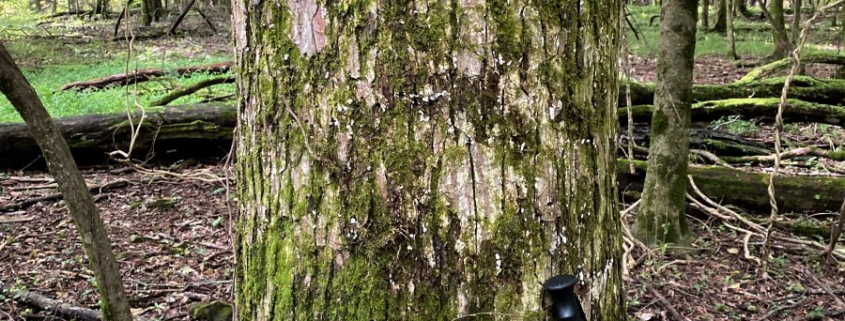State Champion Trees at Joe Wheeler State Park
A personal confession. I am a nemophilist: One who is fond of forests or forest scenery; a haunter of the woods. I did not know the word until recently. Shortly after seeing the term and definition on a very attractive poster with a sylvan scene, I heard a newscaster with respect to some impending catastrophe say, “We’re not out of the woods yet.” I object — I prefer being in the woods! I suppose such sentiment is why folks look askance when I now admit to being a nemophilist! Their expression conveys, “I always knew there was something wrong with you!” I confess, and I shall remain an unapologetic nemophilist.
You who actually read these Posts may also share my affliction. In fact, I hope that is the case! If so, you may even enjoy reading this photo-essay reflecting on the four State Champion trees at Joe Wheeler State Park.
Joe Wheeler State Park’s Four State Champion Trees
July 7, 2020, State Parks Naturalist Emeritus Mike Ezell and I revisited the four Alabama State Champion trees resident to Joe Wheeler State Park. Visit the Alabama Champion Tree website: https://forestry.alabama.gov/Pages/Management/Champion_Tree.aspx. The opening paragraph tells the tale:
Alabama’s Champion Tree Program began in 1970, when 28 trees were listed. In 2017, there were 159 Champion and Co-Champion trees of 143 different species. Modeled after American Forest’s Big Tree Program, it is designed to discover, recognize and preserve the largest of each native tree species in Alabama. Once a champion is declared, its owner and nominator receive certificates, and a permanent marker is placed at the base of the tree. A Champion Tree is the largest of its particular species in Alabama. The Forestry Commission uses a formula developed by American Forests to determine the points assigned to a tree based on three size measurements. The point system is figured as follows: one point for each inch of circumference, plus one point for each foot of height, plus one point for each four feet of average crown spread. Instructions for using this formula can be found on page 12 of the Champion Tree publication.
September Elm
I admit to surviving more than four decades past my forestry bachelors degree without consciously knowing that September elm (Ulmus serotina) existed. Sure, I may have stumbled across a reference to the species in my freshman forest dendrology course. However, I doubt it. From the USDA Forest Service:
September elm grows sporadically from southern Illinois across Kentucky and Tennessee to northern Georgia, northern Alabama, northern Mississippi, Arkansas, and eastern Oklahoma. It is most abundant in Arkansas and Tennessee.
The species is not abundant, and it is foreign to Maryland’s central Appalachian forests where I studied dendrology. I am obviously familiar with the genus Ulmus. And, the species name (serotina) is identical to the black cherry (Prunus serotina), the primary species in the Allegheny Hardwood forests of northwest Pennsylvania and southwest New York where I conducted my doctoral field research. The champion September elm, when registered in 2011, measured 18.77-inches dbh (diameter at breast height; 4.5′ above the ground); 94-feet tall; crown spread at 49-feet. Mike and I did not carry the gear to measure height or crown width, so we simply measured diameter as a crude estimate of growth since 2011. Our July 2020 diameter (21.64″) indicated nearly three inches of diameter increment in just nine years. I declare the tree healthy and vigorous, growing at a pace of six rings per inch. No slowing down this champion. Perhaps it will defend its champion status for many decades to come!
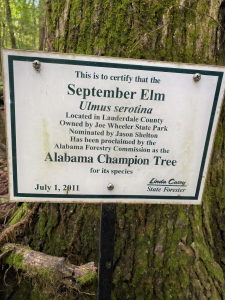
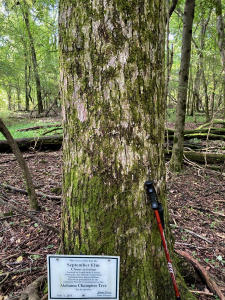
Bitternut Hickory
Bitternut hickory (Carya cordiformis) extends its range across most of the US east of the Mississippi River excepting the deepest South and northern New England. I know it well dating back to freshman forestry. We measured this specimen at 28.67-inches dbh, compared to 21.64-inches in 2011. Seven inches in nine years strikes me as beyond the edge of credulity for a tree in closed-canopy forest. That is, for a tree growing in a fully-stocked forest. Mike and I puzzled over the apparent too-rapid-to-be-true rate of growth. Then we realized the conundrum. The tree separates to three stems within six feet of its base. Although the directory of champion trees lists the diameter, it does not footnote whether the 2011 measurement varied from the traditional point at breast height. This tree is considerably larger at 4.5-feet than even at its base. What we encountered is a point-of-measurement difference and not a growth-beyond-compare super-tree!
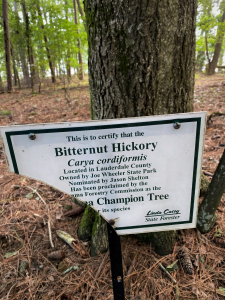
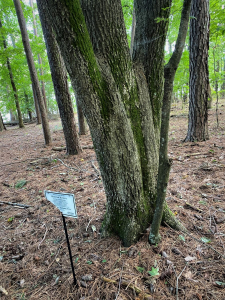
Too bad the identifying sign is broken. Mike will report it to the Forestry Commission. Below left Mike is reviewing the Alabama Champion Tree Directory as he prepares to record a video of our encounter with this individual. Below right is just one more image of this triple-forked champion, with its 82-foot height and 46-foot crown spread. There’s something special about the largest of anything. Alabama boasts some 23-million acres of forestland… that’s roughly 23 million football fields. I just can’t imagine that we’ve accounted for every potential champion tree. In fact, I would place good money that out there somewhere, awaiting discovery, are many new champions.
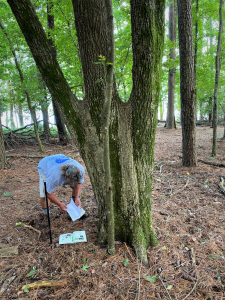
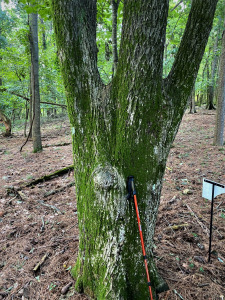
Chinkapin Oak
Another damaged sign greeted us at the state champion chinkapin oak (Quercus muehlenbergii). The USDA Forest Service offers a species snapshot:
Chinkapin oak, sometimes called yellow chestnut oak, rock oak, or yellow oak, grows in alkaline soils on limestone outcrops and well-drained slopes of the uplands, usually with other hardwoods. It seldom grows in size or abundance to be commercially important, but the heavy wood makes excellent fuel. The acorns are sweet and are eaten by several kinds of animals and birds.
Joe Wheeler State Park lies upon limestone bedrock, with rich alkaline soils. Where better to expect our Alabama state champion?! The species’ range covers most of the central and eastern US with the exception of the lower Atlantic and Gulf coastal plains, and much of the northeast. Registered in 2011, this champion measured 21.64-inches dbh, stood 82-feet tall, with a 133-foot crown spread. I didn’t think on-site how truly impressive that spread is. Upon doing the math, I sat at my desk, checking and rechecking my math. The area of a circle is pi (3.1428) times radius squared, right? An acre is 43,560 square feet, again roughly football field size from sideline to sideline and end zone to end zone. Only 3.19 trees this size would fill an acre equivalent!
The diameter had increased to 23.55-inches, nearly two inches in nine years, evidencing once again a healthy individual prospering on the limestone soils on the bluff above Wheeler Lake.
Shingle Oak
The fourth of Joe Wheeler’s champions is an open-growing shingle oak (Quercus imbricaria) near the cabins at Wheeler Dam. As one might expect from a tree not engaging in fierce site resource competition from adjacent forest trees, this champion has little need to fast-forward vertically (height only 68 feet); instead, it gathers additional sunlight by reaching outward (crown spread at 102-feet). Its 2004 diameter has increased from 48.36-inches to today’s 51.22-inches. Were the tree vigorous and in good health the growth would have been far greater. Instead, the crown shows clear evidence of decline; branch dieback appears across the crown. Many decades of soil compaction take a toll on vigor. Eventually, like all living organisms, this tree will succumb to age and other factors. Another shingle oak will assume the champion mantle.
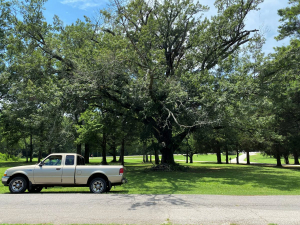
Photo Credit — Mike Ezell
I am a forester, pure and simple. Sure, I like big trees in lawn, street, and landscape settings, yet it is the forest champions that I relish, located in settings where they must compete for limited sunlight, moisture, and nutrients with nearby main canopy occupants. The chinkapin oak’s stature is all the more impressive in that it rose above competitors and muscled out those adjacent trees, effectively claiming their space for its own purposes. Many individuals that fought hard yielded to a tree-equivalent of fatal malnutrition. Their skeletons are scattered about the forest floor. The shingle oak did battle with nothing, accepting only space gifted to it by humans maintaining the open landscape. I accept its champion status, but only reluctantly. I most admire the champions that have earned their place in the Alabama big tree annals.
Learning from Timeless Wisdom
We have all heard verbal elements of antiquity, referring to old truths as wisdom for the ages. Leonardo da Vinci offered such wisdom 500 years ago… wisdom that has stood the test of time. As a once-in-a-millennia artist, he saw the invisible; inferred the improbable; peered with clarity into life, reality, and deep time yet to come. Leonardo da Vinci, 500 years ago, understood the requisite for action.
- I have been impressed with the urgency of doing.
- Knowing is not enough; we must apply. Being willing is not enough; we must do.
These four Alabama tree champions had no option other than to act with urgency day in and day out. Life and death endeavors demand urgency and doing each and every minute 365 days per year.
As did John Muir (1838-1914), applying persistent action through his relationships with Teddy Roosevelt and other notables, power brokers, and influence-peddlers. Muir was a consummate doer. Fifty-six years after Muir’s death, Alabama conservationists created the Alabama State Champion Tree Program, an example of modern-day doing. Muir would approve — he once observed, “The big tree is Nature’s masterpiece, and so far as I know, the greatest of living things.” Muir focused on the western US where the march of settlement had not yet claimed all wilderness. The eastern forests had already suffered the scythe of industrialization, settlement, and domestication. He would not be surprised to know that each of the four Joe Wheeler State Champions is a second-growth tree, growing now after such sweeping original forest disturbance as domestication, conversion to agriculture, and abandonment… Nature reclaiming, healing, and persistently doing what must be done to reach tomorrow.
Protected from future disturbances, true eastern forest giants may arise again… in Alabama on land now protected for posterity: State Parks, National Forests, National Wildlife Refuges, Land Conservancy property, and other lands sheltered in conservation easements.
Alabama State Parks Foundation
I’ll remind you that I serve on the Alabama State Parks Foundation Board, in part because of my love of Nature and in recognition for my writing many prior Posts about visiting and experiencing the Parks. I urge you to take a look at the Foundation website and consider ways you might help steward these magical places: https://asparksfoundation.org/ Perhaps you might think about supporting the Parks System education and interpretation imperative: https://asparksfoundation.org/give-today#a444d6c6-371b-47a2-97da-dd15a5b9da76
The Foundation exists for the sole purpose of providing incremental operating and capital support for enhancing our State parks.
Thoughts and Reflections
John Muir entered this earthly domain 113 years before I entered the world. North America west of the Mississippi was little scarred then by the hands of man, yet he saw the handwriting on the wall, fighting valiantly to sustain some modicum of wildness for future generations. I am grateful for his dedication to the cause of wilderness and wildness. Muir died at age 76 106 years ago. Some of his timeless wisdom:
- The big tree is Nature’s forest masterpiece, and so far as we know, the greatest of living things.
- In every walk with Nature one receives far more than he seeks.
Inhale and absorb Nature’s elixir. May Nature Inspire, Inform, and Reward you!
Note: All blog post images created & photographed by Stephen B. Jones unless otherwise noted. Please circulate images with photo credit: “©2020 Steve Jones, Great Blue Heron LLC. All Rights Reserved.”
Another Note: If you came to this post via a Facebook posting or by an another route, please sign up now (no cost… no obligation) to receive my Blog Post email alerts: http://eepurl.com/cKLJdL
And a Third: I am available for Nature-Inspired Speaking, Writing, and Consulting — contact me at steve.jones.0524@gmail.com
Reminder of my Personal and Professional Purpose, Passion, and Cause
If only more of us viewed our precious environment through the filters I employ. If only my mission and vision could be multiplied untold orders of magnitude:
Mission: Employ writing and speaking to educate, inspire, and enable readers and listeners to understand, appreciate, and enjoy Nature… and accept and practice Earth Stewardship.
Vision:
- People of all ages will pay greater attention to and engage more regularly with Nature… and will accept and practice informed and responsible Earth Stewardship.
- They will see their relationship to our natural world with new eyes… and will understand more clearly their Earth home.
Tagline/Motto: Steve (Great Blue Heron) encourages and seeks a better tomorrow through Nature-Inspired Living!
Steve’s Three Books
I wrote my books Nature Based Leadership (2016), Nature-Inspired Learning and Leading (2017), and Weaned Seals and Snowy Summits: Stories of Passion for Place and Everyday Nature (2019; co-authored with Dr. Jennifer Wilhoit) to encourage all citizens to recognize and appreciate that every lesson for living, learning, serving, and leading is either written indelibly in or is powerfully inspired by Nature.
I began writing books and Posts for several reasons:
- I love hiking and exploring in Nature
- I see images I want to (and do) capture with my trusty iPhone camera
- I enjoy explaining those images — an educator at heart
- I don’t play golf!
- I actually do love writing — it’s the hobby I never needed when my career consumed me
- Judy suggested my writing is in large measure my legacy to our two kids, our five grand kids, and all the unborn generations beyond
- And finally, perhaps my books and Blogs could reach beyond family and touch a few other lives… sow some seeds for the future

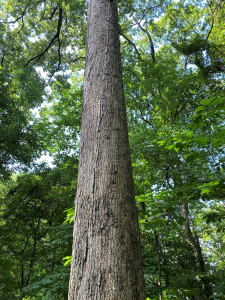
My books (Nature Based Leadership; Nature-Inspired Learning and Leading; Weaned Seals and Snowy Summits) present compilations of personal experiences expressing my (and co-author Dr. Wilhoit for Weaned Seals and Snowy Summits) deep passion for Nature. All three books offer observations and reflections on my relationship to the natural world… and the broader implications for society. Order any and all from your local indie bookstore, or find them on IndieBound or other online sources such as Amazon and LifeRich.

